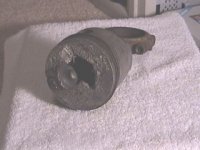DimensionDude
Experienced Member
A friend has given me two Toyota Corollas. Both are 1987 models, the only difference is that one is an LE (nicer seats, OD trans, extra trim). The catch is that neither one runs. The LE was used as a postal delivery vehicle on a rural route so it's kinda rough looking. She (my friend) let it run low on oil and apparently spun a bearing on the crankshaft. Actually, this one will run but with a diesel-like clatter that is horrible to hear.
The other one is in excellent condition. No dents, not even a scratch. The top end of the motor is in the trunk. Neither of us has any idea why the motor is half torn down, she bought it like that with the intention of pulling the motor out of the LE (before she damaged it).
Can't really find anything wrong with the top end, head, valves, combustion chamber looks good. Bottom end turns freely, absolutely no wear in the cylinders, light carbon buildup on top of pistons.
My plan is to put the head back on it and run a compression test. Might have bad rings or something.
Kent
The other one is in excellent condition. No dents, not even a scratch. The top end of the motor is in the trunk. Neither of us has any idea why the motor is half torn down, she bought it like that with the intention of pulling the motor out of the LE (before she damaged it).
Can't really find anything wrong with the top end, head, valves, combustion chamber looks good. Bottom end turns freely, absolutely no wear in the cylinders, light carbon buildup on top of pistons.
My plan is to put the head back on it and run a compression test. Might have bad rings or something.
Kent

